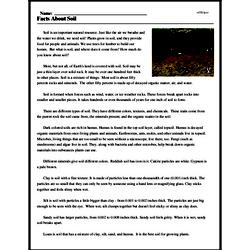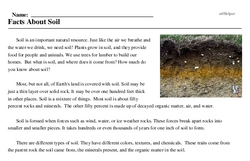Facts About Soil
Soil is an important natural resource. Just like the air we breathe and the water we drink, we need soil! Plants grow in soil, and they provide food for people and animals. We use trees for lumber to build our homes. But what is soil, and where does it come from? How much do you know about soil?
Most, but not all, of Earth's land is covered with soil. Soil may be just a thin layer over solid rock. It may be over one hundred feet thick in other places. Soil is a mixture of things. Most soil is about fifty percent rocks and minerals. The other fifty percent is made up of decayed organic matter, air, and water.
Soil is formed when forces such as wind, water, or ice weather rocks. These forces break apart rocks into smaller and smaller pieces. It takes hundreds or even thousands of years for one inch of soil to form.
There are different types of soil. They have different colors, textures, and chemicals. These traits come from the parent rock the soil came from, the minerals present, and the organic matter in the soil.
Dark colored soils are rich in humus. Humus is found in the top soil layer, called topsoil. Humus is decayed organic materials from once-living plants and animals. Earthworms, ants, moles, and other animals live in topsoil. Microbes, living things that are too small to be seen without a microscope, live there, too. Fungi (such as mushrooms) and algae live in soil. They, along with bacteria and other microbes, help break down organic materials into substances plants can use.




